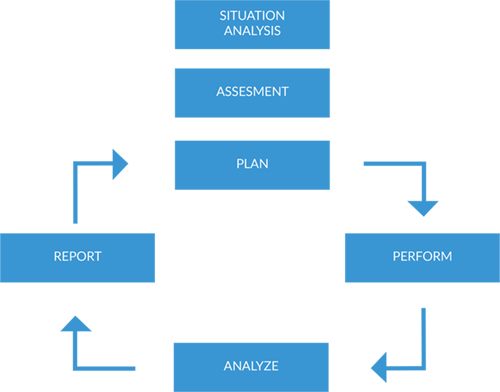THE OKTAN METHOD
A method for analyzing and improving your manufacturing and management processes
The OKTAN method
The OKTAN method can promise fast and efficient payback and increased profit, decrease of production cost and improved working conditions. OKTAN method will take approximately 3-4 working weeks during a 3-5 months period to fulfill. The payoff for the cost and work using OKTAN method is approximately 9-12 months.
The OKTAN method has been developed and evaluated during more than 30 years globally in automotive, consumer electronics and the telecom industries. The OKTAN method has developed into a method that systematically analyzes and optimizes a company’s operation process and performance, especially in technical capability, capacity and production value.
How it works
The OKTAN method is performed in three steps, with an optional final step called Process Re-Engineering. Each of the steps follows an established guideline, template and documentation.
Step 1: Situation Analysis
We walk through operation status analyzing the current situation. The formal and informal operations and processes are analyzed together with interviews of staff, suppliers and customers.
Step 2: Assessment
The assessment will be verifying the existing operational performance covering employees, machinery, management, production, quality system, infrastructure and processes. The result is weighted in our data base and compared with similar companies. A unique rating, with the value and position for the evaluated company, will be the result.
From this assessment, we can decide for an improvement plan (PPAR).
The Assessment tool, including PPAR, will also be available in a “light” web version for easy self-assessment. This to a give a quick update on status and potential development and improvement areas.
Step 3: PPAR (Prepare, perform, analyze and report)
From the assessment, we have the material and information necessary for making an improvement plan. Our standard PPAR will be the tool to test and verify our findings.
Prepare: Decide, describe and prepare for what to do, how to do it when do it and where to do.
Perform: Perform and document the tests, controls or operation which has been prepared.
Analyze: Analyze the result.
Report: Report the result, findings and way forward.

Option: Process Re-Engineering
The Process Re-Engineering starting with a blank page and challenging the current setup.
There are no existing or historical operations.
The basic and simple question is: What is our customer expectations and how can we provide that?
The OKTAN method
The OKTAN method can promise fast and efficient payback and increased profit, decrease of production cost and improved working conditions. OKTAN method will take approximately 3-4 working weeks during a 3-5 months period to fulfill. The payoff for the cost and work using OKTAN method is approximately 9-12 months.
The OKTAN method has been developed and evaluated during more than 20 years globally in automotive, consumer electronics and the telecom industries. The OKTAN method has developed into a method that systematically analyzes and optimizes a company’s operation process and performance, especially in technical capability, capacity and production value.

How it works
The OKTAN method is performed in three steps, with an optional final step called Process Re-Engineering. Each of the steps follows an established guideline, template and documentation.
Step 1: Situation Analysis
We walk through operation status analyzing the current situation. The formal and informal operations and processes are analyzed together with interviews of staff, suppliers and customers.
Step 2: Assessment
The assessment will be verifying the existing operational performance covering employees, machinery, management, production, quality system, infrastructure and processes. The result is weighted in our data base and compared with similar companies. A unique rating, with the value and position for the evaluated company, will be the result.
From this assessment, we can decide for an improvement plan (PPAR).
The Assessment tool, including PPAR, will also be available in a “light” web version for easy self-assessment. This to a give a quick update on status and potential development and improvement areas.
Step 3: PPAR (Prepare, perform, analyze and report)
From the assesment, we have the material and information necessary for making an improvement plan. Our standard PPAR will be the tool to test and verify our findings.
Prepare: Decide, describe and prepare for what to do and how to do it.
Perform: Perform and document the tests, controls or operation which has been prepared.
Analyze: Analyze the result.
Report: Report the result, findings and a way forward.
Option: Process Re-Engineering
The Process Re-Engineering starting with a blank page and challenging the current setup.
There are no existing or historical operations.
The basic and simple question is: What is our customer expectation and how can we provide that?